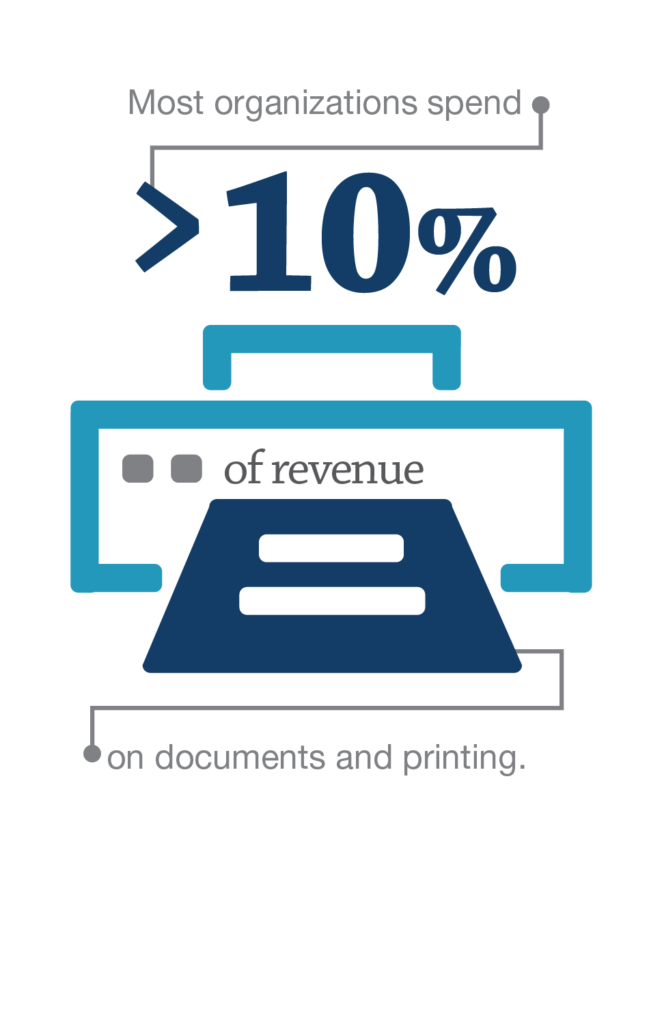Well, not you personally. Even so, if you’re a C-level IT, operations or financial leader in your organization, I have a pretty good idea what’s on your mind these days. It’s kinda my job.
At IDC, we have access to an enormous amount of research. The result: we develop a clear view of what people are thinking. In my practice area, much of it revolves around document solutions. So if your role involves documents or document processes, I invite you to read on.
For instance, I’ll bet your IT spend is shrinking relative to your company’s growth as it is for most companies, which means you can’t readily invest in new systems or technologies like you have in the past. It’s pretty much maintenance mode, right?
 Or maybe your team is looking for ways to do more with less investment. An option so many are embracing is the cloud—move things onto scalable servers you don’t own or need to maintain. Sound familiar?
Or maybe your team is looking for ways to do more with less investment. An option so many are embracing is the cloud—move things onto scalable servers you don’t own or need to maintain. Sound familiar?
Something else I know that you may not even have thought about yet, but you will: your document spending as a percentage of revenue.
For most organizations it’s over 10 percent, when you factor in the full document lifecycle. Yeah, double digits.
If you’re in healthcare, you’re spending about 15 percent of all the money coming in on documents and printing. Of course, it’s a cost of doing business. But what about customers, what about subscribers, what about patients? Shouldn’t more of your dollars be focused on delivering services to them? So, with all that revenue going toward documents and printing, yet the IT spending share going down, there ought to be a way to reconcile the two. Maybe free up some of the document-related spend to reinvest in technology.
That’s where the concept of Managed Document and Print Services is taking hold in organizations across the U.S. and around the world.
Let’s go a little deeper. (This won’t hurt, I promise.)
There are some megatrends that have come onto my radar. And I have to believe you’re seeing them, too. These are factors in your head but with no clear mandate as to what to do about them. In your emails and conference notes, I bet they’re called “considerations.” Have any of these topics crossed your mind or your desk lately?
Business-related:
Customers expect more
They want faster response times and more value for every dollar spent.
Revenue growth
Even as budgets decrease and competition increases, stakeholders expect revenue to grow. It’s the only way to keep moving forward.
Cost containment
You’re looking everywhere to prevent costs from going up. Yet employees expect modest raises. Healthcare costs increase. Raw materials rarely go down. There are few opportunities to save.
Risk mitigation, compliance and business continuity
Every industry has its own specifics, but risk and compliance are realities you can’t ignore. And they cost real money.
On the IT side:
Whether you directly manage IT or not, you’re no doubt familiar with these big drivers:
Mobility
Your company is investing in smartphones and tablets and also having to address employees bringing their own smartphones and tablets to work. You are looking for ways to manage and control all these new devices in a secure, productive and cost-effective way. The fact is, these mobile devices help employees to be more productive, so that’s a good thing, right? Sure, if you can manage it effectively. Security and printing from mobile devices are the two biggies to consider.
Cloud
Wish you had a round of golf for every time you heard this word in 2013? Well, cloud use is growing fast and is beyond early adopter phase. It’s a smart way to save money and provide broad access to documents and apps. Again, security is a factor. Printing from the cloud is a factor. Finding cloud providers you can trust is a factor.
Social media
Not your job? It’s everybody’s job now. You can’t ignore LinkedIn, Facebook, Twitter, Pinterest, FourSquare, Instagram, etc. Of course, no single person can keep up, but if you don’t have a strategy, you don’t have a chance.
Digital content explosion
If you’re reading this on an iPad® or computer, you’re experiencing the digital content explosion. If your team is generating blogs, tweets, articles and online videos, you’re contributing to the explosion. It’s a good thing, but it can be overwhelming and has big implications for document management and security.
Predictive big-data analytics
After the cloud, big data may be the most talked about trend, with good reason. The promise of extensive data that helps us make smarter marketing decisions, down to dynamic pricing, has arrived. We’re hacking the genome in terms of customer data. It takes some serious computing power and dedicated analytics.
How’s that shrinking IT budget working for you? You’re having to make tough choices between maintaining operations and new investments like this.
Lots of opportunities if you tackle them right. And you could probably find a different partner to help you address every one of these trends.
Truth is, though, every partner you have now—and those you consider in the future—should all be knowledgeable about these trends, and their offerings must work within these contexts. They should all be able to help you address the changing business landscape in ways large and small.
Is relying on a printer company for document lifecycle management like the tail wagging the dog?
Most of the leading managed document and print service providers grew up in, well, digital printing. They have products that sit at the end of your network, providing hard copy and scanning. For years they were literally and figuratively “peripheral.”
From that vantage point, however, they’ve been able to see how work gets done in organizations large and small. One in particular has already transformed into a services provider, now with over half its revenue from services. That’s Xerox Corporation. The people, the know-how, have become even more valuable assets in the new marketplace than its strong technology. What does this mean for you?
If your IT spend is under pressure, if you’re looking for new ways to streamline business processes and cut costs, if you’re exploring the concept of Managed Document and Print Services, one of the providers you should consider is Xerox.
Xerox is a leader in IDC’s Worldwide Managed Print Services (MPS) MarketScape and the largest worldwide MPS provider.* I’m not saying that’s who you should choose, but I am saying that they should be on your short list if you want to realize the promise of MPS at your organization. MPS encompasses document-intensive business processes and print.
If I could plant an idea in your mind this year it would be this: a Managed Document and Print Services approach could save you money and headaches in the years ahead.
It’s not a simple decision. But it can transform your operation and free up time and money in surprising ways. Definitely worth exploring. Feel free to contact me.
Top three things to look for in a Managed Document and Print Services provider:
Experience
- MPS/MDS track record
- Vertical industry expertise and benchmarks
Portfolio (partner-owned and partner’s ecosystem)
- Leading-edge technology—color, scanning, print/document management tools, security, sustainability
- Services breadth—business process document management (including. paper/digital integration); IT skills (e.g., network, cloud, mobility, security); ability to manage mixed brand environments
- Mobile/remote workforce document management; secure print/scan support
- External print procurement (e.g., marketing collateral, training materials, mobile/remote worker printing)
Source: IDC, 2012
 Angèle Boyd is an industry analyst at IDC. She has her finger on the pulse of the fast-growing trend toward Managed Document & Print Services as a way to control document-related costs and free up resources for more important business priorities.
Angèle Boyd is an industry analyst at IDC. She has her finger on the pulse of the fast-growing trend toward Managed Document & Print Services as a way to control document-related costs and free up resources for more important business priorities.
For more information about Xerox Managed Print Services, visit www.office.xerox.com/managed-print-services/
*Source: IDC MarketScape: Worldwide Managed Print Services 2011 Hardcopy Vendor Analysis, Dec 2011, Doc # 232135, by Holly Muscolino, Research Director, Hardcopy Peripherals: Software and Services.
All IDC research is ©2012 by IDC. All rights reserved. All IDC materials are licensed with IDC’s permission and in no way does the use or publication of IDC research indicate IDC’s endorsement of Xerox’s products, services, and/or strategies.




